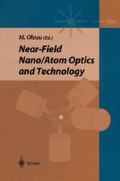Abstract
In general, a serious problem of the fiber probe is its low throughput (in the case of illumination-mode operation, the throughput is defined as the ratio of the output light power at the apex of the fiber probe to the light power coupled into the other end of the probe). The essential cause of the low throughput is the guiding loss along (or inside) the metallized tapered core. In order to study this loss mechanism and to realize high-throughput probes, we focus our discussion on the characteristics of the tapered core. Since the nanometric protruded part at the top of the fiber probe does not contribute to this loss, this chapter treats only the fiber probe without a protruded part, i.e., a flat-apertured probe. Its cross-sectional profile is shown in Fig. 4.1a, for which the foot diameter df of the protruded probe in Fig. 4.1b can be called the aperture diameter.
Access this chapter
Tax calculation will be finalised at checkout
Purchases are for personal use only
Preview
Unable to display preview. Download preview PDF.
References
U. Dürig, D. W. Pohl, F. Rohner, J. Appl. Phys. 59, 3318 (1986)
L. Novotony, D. W. Pohl, B. Hecht, Opt. Lett. 20, 970 (1995)
L. Novotony, C. Hafner, Phys. Rev. E 50, 4094 (1994)
D. Marcuse, Light Transmission Optics, Chap. 10 (Van Nostrana Reinhold Company, New York, 1972)
T. Yatsui, M. Kourogi, M. Ohtsu, Appl. Phys. Lett. 71, 1756 (1997)
T. Pangaribun, K. Yamada, S. Jiang, H. Ohsawa, M. Ohtsu, Jpn. J. Appl. Phys. 31, L1302 (1992)
S. Mononobe, M. Naya, T. Saiki, M. Ohtsu, Appl. Optics. 36, 1496 (1997)
Y. Inoue, S. Kawata, Opt. Lett. 19, 159 (1994)
T. Saiki, S. Mononobe, M. Ohtsu, N. Saito, J. Kusano, Appl. Phys. Lett. 68, 2612 (1996)
Author information
Authors and Affiliations
Editor information
Editors and Affiliations
Rights and permissions
Copyright information
© 1998 Springer Japan
About this chapter
Cite this chapter
Ohtsu, M. (1998). High-Throughput Probes. In: Ohtsu, M. (eds) Near-field Nano/Atom Optics and Technology. Springer, Tokyo. https://doi.org/10.1007/978-4-431-67937-0_4
Download citation
DOI: https://doi.org/10.1007/978-4-431-67937-0_4
Publisher Name: Springer, Tokyo
Print ISBN: 978-4-431-68013-0
Online ISBN: 978-4-431-67937-0
eBook Packages: Springer Book Archive

